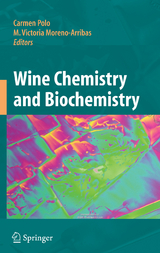Wine Chemistry and Biochemistry
Springer-Verlag New York Inc.
978-0-387-74116-1 (ISBN)
The first part of the book summarizes the most important aspects of winemaking technology and microbiology. The second most extensive part deals with the different groups of compounds, how these are modified during the various steps of the production process, and how they affect the wine quality, sensorial aspects, and physiological activity, etc. The third section describes undesirable alterations of wines, including those affecting quality and food safety. Finally, the treatment of data will be considered, an aspect which has not yet been tackled in any other book on enology. In this chapter, the authors not only explain the tools available for analytical data processing, but also indicate the most appropriate treatment to apply, depending on the information required, illustrating withexamples throughout the chapter from enological literature.
Carmen Polo is Research Professor at the Institute of Industrial Fermentations of the Spanish National Research Council (CSIC) at Madrid, Spain. She was the Director of the Institute from 1991 through 2002. She is member of the experts group of the Sub-Commission of Methods of Analysis from the International Organisation of Vine and Wine (OIV). She was awarded with the OIV prize for the book "El vinagre de vino". Dr. Polo is author of more than 90 research papers in peer reviewer journals and more than 20 books chapters in books of scientific editorials. M. Victoria Moreno-Arribas is a Senior at the Institute of Industrial Fermentations of the Spanish National Research Council (CSIC) at Madrid, Spain. She is member of the Spanish Delegation as an expertise in the International Organization of Vine and Wine (OIV). She is also been appointed Professor of Enology by the Autonoma University of Madrid (UAM). She is author in over 70 SCI papers and 18 book chapters in books of scientific editorials.
Chemical and Biochemical Aspects ofWinemaking.- Biochemistry of Alcoholic Fermentation.- Biochemical Transformations Produced by Malolactic Fermentation.- Special Wines Production.- SparklingWines and Yeast Autolysis.- Biologically Aged Wines.- Enzymes in Winemaking.- Use of Enological Additives for Colloid and Tartrate Salt Stabilization in White Wines and for Improvement of Sparkling Wine Foaming Properties.- Wine Chemical Compounds and Biochemical Processes.- Nitrogen Compounds.- Amino Acids and Biogenic Amines.- Peptides.- Proteins.- Carbohydrates.- Volatile and Aroma Compounds.- Wine Aroma Precursors.- Polyfunctional Thiol Compounds.- Volatile Compounds and Wine Aging.- Yeasts and Wine Flavour.- Identification of Impact Odorants of Wines.- Interactions Between Wine Matrix Macro-Components and Aroma Compounds.- Phenolic Compounds.- Anthocyanins and Anthocyanin-Derived Compounds.- Flavanols, Flavonols and Dihydroflavonols.- Non-flavonoid Phenolic Compounds.- Influence of Phenolics on Wine Organoleptic Properties.- Health-Promoting Effects of Wine Phenolics.- Spoilage ofWines.- Aromatic Spoilage of Wines by Raw Materials and Enological Products.- Wine Spoilage by Fungal Metabolites.- Automatic Analysers and Data Processing.- Automatic Analysers in Oenology.- Statistical Techniques for the Interpretation of Analytical Data.
| Zusatzinfo | XV, 735 p. |
|---|---|
| Verlagsort | New York, NY |
| Sprache | englisch |
| Maße | 156 x 235 mm |
| Themenwelt | Naturwissenschaften ► Biologie ► Biochemie |
| Naturwissenschaften ► Chemie ► Technische Chemie | |
| Technik ► Lebensmitteltechnologie | |
| ISBN-10 | 0-387-74116-X / 038774116X |
| ISBN-13 | 978-0-387-74116-1 / 9780387741161 |
| Zustand | Neuware |
| Haben Sie eine Frage zum Produkt? |
aus dem Bereich




